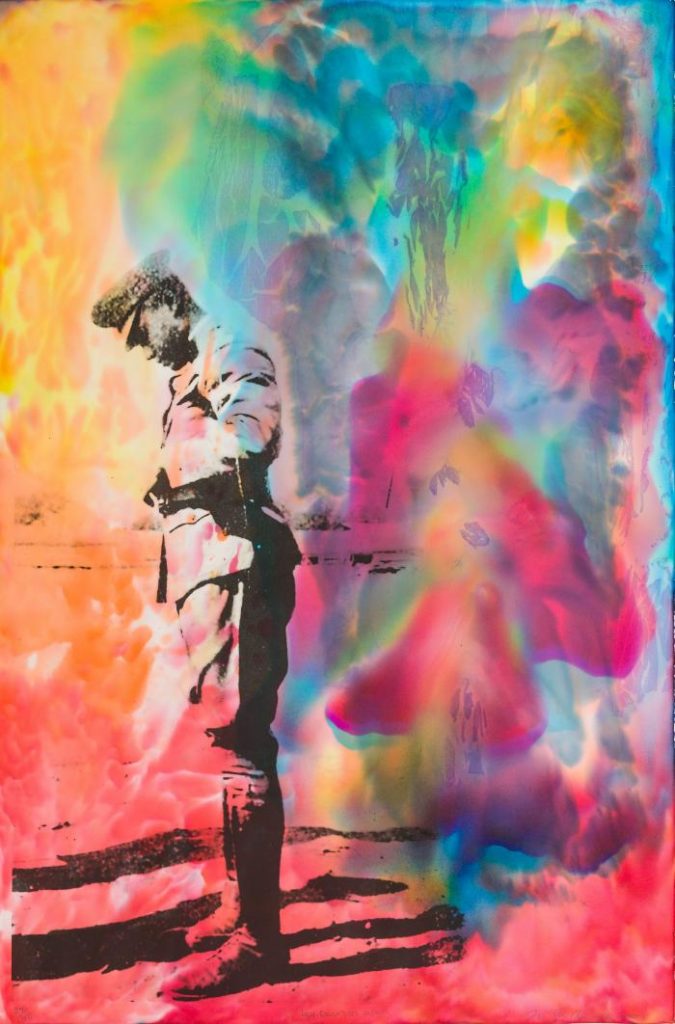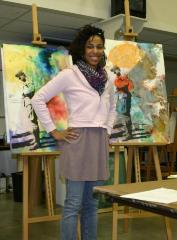
Down on War
Maya Freelon
- 2009
- Offset Lithograph
- Image/sheet: 26 x 40"
- 40 prints in this edition
About the Print
From the Artist
In 2005, I discovered a beautiful accident in my grandmother’s basement: a stack of tissue paper was stained by water from a leaking pipe. Finding the watermarked paper changed the trajectory of my artistic career.
Both delicate and resilient, the use of tissue paper poses questions surrounding preservation, ‘high’ and ‘low’ art, and the attribution of value for objects. What fuels our desire to protect? What makes something precious? How much pressure is needed until something is ripped? Is it destroyed? Can one find strength and power in fragility? Do you still appreciate the beauty of now, even if you know it will ultimately fade away? My Godmother and namesake, Maya Angelou, said it most eloquently when she described my artwork as “visualizing the truth about the vulnerability and the strength of the human being.”
Although I do work with paper, it is fortified, strong and resilient. I’ve created permanent installations around the world, and am now expanding outside the gallery and museum walls, into corporate venues, government institutions, hotel/hospitality, healthcare facilities, and private events. Reactions to my installations are varied, from the young to the old, they all include immense curiosity.
Tissue paper as a medium reflects my own personal struggles and allows me to visualize the whimsical and transient nature of emotions. Even after working over 14 years with the same medium, I am still finding new ways to play!
—From https://www.mayafreelon.com/statement, accessed 6-18-2021
Maya Freelon’s great-grandfather Allan Freelon used art as therapy to recover from injury and traumatic stress during service in Europe during World War I. He later became the first Black art supervisor for the school district in his hometown of Philadelphia.
—From Brandywine Workshop and Archives records
About the Artist
Maya Freelon was born in Houston, TX, to Nnenna Freelon and Philip Freelon. Her mother was a jazz singer and her father was an architect. Coming from a family of supportive artists, Freelon discovered her passion for art before she could read. Her great-grandfather Allan Freelon was a pioneer African American Impressionist painter during the Harlem Renaissance. She earned a BA from Lafayette College, Easton, PA, and an MFA from the School of Museum of Fine Arts, Boston (now Tufts School of the Museum of Fine Arts).
Freelon has been exhibited nationally and internationally, including shows in Paris, Jamaica, Madagascar, and Italy. Her work is in the collections of U.S. State Department, U.S. embassies in Madagascar and Rome; Smithsonian National Museum of African American History and Culture, Washington, DC; University of Maryland David C. Driskell Center, College Park; Museum of the National Center of Afro-American Artists, Boston; Reginald F. Lewis Museum, Baltimore, MD; University of North Carolina, Chapel Hill; Lafayette College; Brandywine Workshop and Archives; School of the Museum of Fine Arts, Boston; Williston Northampton School, Easthampton, MA; and Kokrobitey Institute, among others.
Freelon has completed residencies at the Skowhegan School of Painting and Sculpture, ME; Korobitey Institute, Ghana; and Brandywine Workshop and Archives, Philadelphia.
The late poet Maya Angelou described Freelon’s work as “visualizing the truth about the vulnerability and power of the human being.”
—Adapted from https://www.mayafreelon.com/about-ba and https://en.everybodywiki.com/Maya_Freelon_Asante, accessed 6-22-2021
Curriculum Connections
Suggested Topics for Portraiture (in studio art and art history education), Visual Narratives, Expressive Writing:
Art in memoriam
Let us now look at the use of words or a combination of words, symbols, and human images to convey deeply felt emotions. Creative people — artists, musicians, dancers, and writers — often create new works bearing witness to the death of a loved one, especially when it is a tragic death or the result of a catastrophic event like an environmental or health disaster such as COVID-19.
Questions to Consider
- Art memorials take many forms, including paintings, prints, and sculpture. Have you ever created one?
- What do you feel is the best way to represent someone who has died? What metaphors can be used in art to represent someone’s death or dying?
- What symbols or elements of art reflect the passing of a human spirit and have personal meaning for you?
- If you were to create a composition from words (see Edgar Heap of Birds and Ayanah Moor), what nouns, adjectives, and adverbs would you use to convey your emotions?
